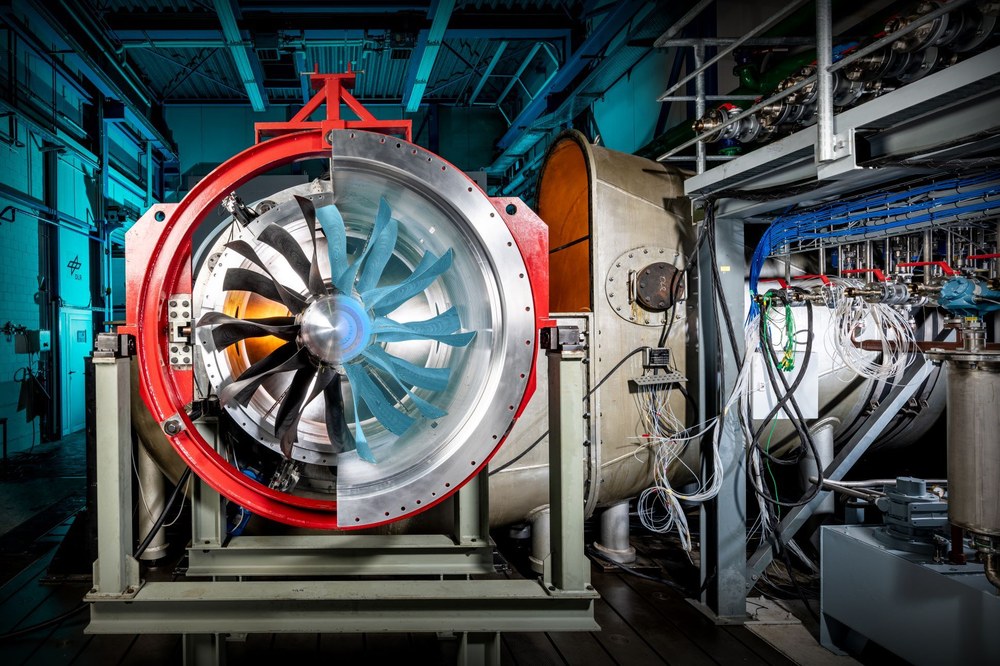Energy converter gas turbine

A networked energy system in which the electricity, heat and transport sectors are viewed comprehensively as a complex unit requires the use of various different energy converters. Gas turbines can be used to efficiently generate electricity from gaseous or liquid fuels. Today, gas turbine power plants almost exclusively use natural gas. However, in the future, they will increasingly be operated in a climate-neutral manner using fuels from renewable sources. Because of their flexibility regarding performance and fuels, gas turbines can take on a balancing and supplementary role in the future energy system.
This research work is being carried out at the DLR Institute of Combustion Technology, the DLR Institute of Propulsion Technology and the DLR Institute of Materials Research.
Total gas turbine system
The gas turbine system consists of three main components – the compressor, the combustion chamber and the turbine. The system must be designed with pinpoint accuracy and optimised for the requirements of future energy systems that will be operated on a flexible basis. To develop gas turbines, investigations into flow fields, the chemical reactions that occur during combustion, and the resulting modelling of components are essential. In atmospheric and high-pressure test stands, detailed measurements are carried out on optically accessible combustion chambers under realistic conditions using optical and laser-based methods. Aerodynamic investigations take place on special compressor or turbine test rigs. DLR has developed extensive numerical simulation tools for modelling: the THETA flow-solver to simulate flows in the combustion chamber, TRACE for high-precision simulation of multi-stage compressors and turbo engines of all types under stationary and unsteady conditions, AutoOpti for an automated design optimisation, and GTLab to simulate the entire gas turbine system.
In the development of novel combustor systems, the focus is on stationary gas turbines in performance classes from one kilowatt of electrical power to several hundred megawatts. In addition to the swirl burner concepts currently most frequently used, new types of FLOX® combustion chambers in particular are being investigated; these have high fuel flexibility, a broad operating range and low susceptibility to thermoacoustics.
Emissions
The reduction in pollutant gas emissions is an important driver in the development of new combustion chambers for gas turbines and the design of future synthetic fuels. The relevant pollutants are nitrogen oxides, carbon monoxide, residual unburnt hydrocarbons and, for liquid fuels, soot. At the same time, emissions of the greenhouse gas carbon dioxide should also be reduced. One particular challenge lies in developing combustion concepts with low emissions that at the same time guarantee fuel and load flexibility, and allow an increase in efficiency and reliable operation.
An improvement in physical-chemical models and their incorporation in computing codes are required in order to design combustion sequences that result in lower emissions. Models are constructed on the basis of research into reaction kinetics using shock wave tubes and spectroscopic laser measurements on both generic combustion systems and test rigs to simulate technically relevant flame conditions.
Unsteady combustion processes
Unsteady combustion processes, such as ignition (spontaneous and external ignition), quenching and unstable flames, are highly significant in gas turbine combustion chambers. These generally unwanted processes are heavily characterised by the interaction between the flow field and combustion reactions. Both numerical simulations and experimental investigations of this highly dynamic phenomena are very challenging. In order to analyse the chronological sequence of unsteady processes, high-speed laser measuring techniques are used on generic and realistic combustion chambers. These findings are then again integrated in complex combustion models in order to be able to simulate real systems as accurately as possible.
Power plant concepts based on microgas turbines
Microgas turbines with electrical outputs of one to several hundred kilowatts are used for the decentralised supply of power and heat (combined heat and power; CHP) in buildings, commerce, trade, services, and small and medium-sized industrial enterprises. Compared to large power stations, the benefit of generating energy through small, local CHP units is that there are no major losses due to transportation or conversion besides fuel transport, and the end user is provided with heat in addition to the generated electricity. The focus of DLR’s research activities is on the development and design of power plant concepts based on microgas turbines.
